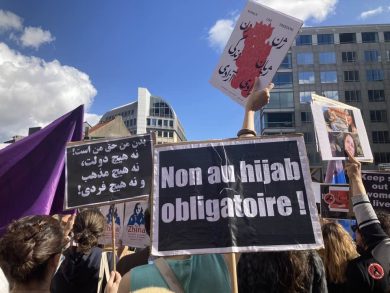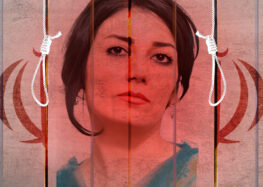Since its founding in 1979, the Islamic Revolutionary Guard Corps (IRGC) has positioned itself as the guardian of Iran’s Islamic Revolution. In practice, however, it has evolved into a repressive and militarized institution responsible for a systematic campaign of human rights abuses both inside and outside of Iran. Acting as an armed extension of the Supreme Leader’s will, the IRGC has crushed dissent, terrorized civilians, assassinated dissidents, and exported violence abroad.
This timeline-based analysis chronicles over four decades of the IRGC’s atrocities, documenting major milestones of repression, war crimes, and state-sponsored terror. It also explores how this pattern of abuse constitutes not isolated events but a sustained and deliberate assault on human rights that demands global recognition and accountability.
1. 1979–1980s: Revolution, Purges, and the Establishment of State Violence
1979:
• The IRGC is created by Ayatollah Khomeini to “protect the revolution.”
• It immediately begins suppressing rival factions: leftists, liberals, monarchists, and ethnic minorities.
1980–1988:
• During the Iran-Iraq War, the IRGC’s intelligence arm oversees the mass persecution of Kurdish and Baloch minorities, often labeling them as separatists or “anti-Islamic.”
1981–1983:
• Thousands of members of the opposition Mojahedin-e Khalq (MEK) are detained, tortured, and executed.
1988:
• The 1988 Massacres:
• Over 5,000 political prisoners—many of them leftists and MEK affiliates—are executed following closed-door “death commissions.”
• The IRGC helps compile lists of prisoners, carries out executions, and buries bodies in mass graves.
2. 1990s: Silencing Dissent and Regional Expansion
1994:
• The AMIA bombing in Buenos Aires, which kills 85 and injures hundreds at a Jewish community center, is attributed to Hezbollah with direct IRGC-Quds Force coordination.
1996:
• U.S. courts find IRGC responsible for the Khobar Towers bombing in Saudi Arabia, which kills 19 American service members.
Late 1990s:
• The IRGC’s Intelligence Organization is linked to the “Chain Murders” of intellectuals and opposition figures in Iran.
• Victims include Dariush and Parvaneh Forouhar, political dissidents.
3. 2000–2009: Consolidating Control, Cracking Down on Reform
2003–2008:
• The IRGC strengthens its control over the Iranian economy, silencing journalists and critics who expose corruption or question the militarization of governance.
2005:
• Mahmoud Ahmadinejad, an IRGC-aligned figure, becomes president. The IRGC’s influence in domestic security and foreign policy intensifies.
2009: The Green Movement
• After allegations of election fraud, millions protest across Iran.
• The IRGC and Basij militia respond with mass arrests, beatings, torture, and live fire.
Human Rights Abuses:
• Students raped in Kahrizak Detention Center
• Dissidents beaten and forced into televised confessions
• Dozens killed, thousands injured or jailed
4. 2010–2015: Terror Plots Abroad and Suppression at Home
2011:
• U.S. uncovers IRGC-Quds Force plot to assassinate the Saudi ambassador in Washington, D.C.
• Global scrutiny of the IRGC’s extraterritorial operations increases.
2012–2015:
• The IRGC deploys thousands of fighters to support Bashar al-Assad in Syria.
• IRGC-backed militias commit war crimes including:
• The siege of Aleppo
• Targeting hospitals and civilians
• Ethnic cleansing of Sunni areas
Inside Iran:
• Women’s rights activists like Narges Mohammadi and Nasrin Sotoudeh are imprisoned for peaceful advocacy.
• Journalists covering economic protests face IRGC surveillance, arbitrary detention, and torture.
5. 2017–2019: Escalation of Protest Suppression
2017–2018:
• Nationwide protests erupt over economic hardship and political corruption.
• The IRGC deploys riot units and Basij to crush demonstrations.
November 2019:
• One of the deadliest crackdowns in Iran’s history.
• Over 1,500 protesters killed in just a few days, according to Reuters and UN reports.
• IRGC cuts off internet access nationwide to hide the scale of violence.
• Detainees report beatings, rape, and mock executions.
6. 2020–2021: Assassinations, Executions, and the COVID Crackdown
2020:
• Wrestler Navid Afkari is executed following a forced confession obtained under torture by IRGC-affiliated interrogators.
2020:
• The IRGC kills at least 176 civilians by shooting down Ukraine International Airlines Flight 752, allegedly mistaking it for a military threat.
• It denies responsibility for days, then arrests protesters demanding accountability.
2021:
• Reports emerge of mass cyber surveillance by IRGC Intelligence, targeting women, students, and LGBTQ+ Iranians.
7. 2022–2023: “Woman, Life, Freedom” and the Regime’s Brutal Response
September 2022:
• Mahsa (Jina) Amini, 22, dies in custody after being arrested for “improper hijab” by the morality police (under IRGC-linked Ministry of Interior).
Nationwide Protests Follow:
• Women remove hijabs, burn symbols of the regime, chant “Death to the Dictator.”
• Schoolgirls, university students, teachers, and artists join in.
IRGC Response:
• Deploys snipers and plainclothes agents to crush protests
• Targets Kurdish cities with heavy artillery
• Chemical attacks reported in hundreds of girls’ schools, widely suspected to be IRGC-related
Human Rights Violations:
• Over 20,000 arrested
• At least 500 killed (as of 2023), many under 18
• Rape, solitary confinement, and torture documented
8. Transnational Repression and Assassination Plots
2018–2023:
• IRGC-linked operatives caught plotting attacks or assassinations in:
• France, Germany, Turkey, Denmark, Netherlands, and the U.S.
• Masih Alinejad, Iranian-American journalist, targeted by multiple abduction and murder plots
• Dissidents abducted abroad (e.g., Ruhollah Zam) and executed after forced repatriation
These plots show that IRGC repression is global—dissidents are never truly safe, even in exile.
9. Gender-Based Violence and Persecution
The IRGC enforces gender apartheid as part of its ideological mission.
Documented Practices:
• Sexual assault and threats used in interrogation
• Surveillance of women’s social media and private lives
• Arrest and torture for “improper hijab” or feminist activism
• Forcible “virginity tests” in detention centers
• Mass imprisonment of women human rights defenders
Prisons like Qarchak and Evin are infamous for abuse under IRGC administration or oversight.
10. Ongoing Crimes: Cyber Terror, Censorship, and Youth Targeting
IRGC Cyber Units:
• Hack diaspora journalists and activists
• Deploy spyware apps disguised as VPNs or Islamic content
• Use facial recognition to identify protest participants
Children Targeted:
• Teenage girls arrested, beaten, and raped for protesting
• Schoolchildren forced to watch state propaganda
• Minors charged with national security crimes
11. Why This Pattern Constitutes Crimes Against Humanity
The IRGC’s record is not a series of accidents—it is a sustained pattern of state-sponsored violence targeting civilians.
Elements of Crimes Against Humanity (Rome Statute):
• Widespread or systematic attack on civilian population
• Acts include:
• Murder
• Torture
• Rape
• Enforced disappearance
• Persecution
• Other inhumane acts
The IRGC fulfills all of these criteria.
12. Calls for Justice and Accountability
Legal Action:
• Universal jurisdiction cases filed in Germany and Sweden
• Magnitsky sanctions on IRGC commanders
• ICC referrals being discussed based on cross-border crimes
International Support:
• UN Fact-Finding Mission on Iran (est. 2022)
• European Parliament resolution calling for IRGC designation
• Activist coalitions demanding full IRGC terrorist designation globally
Conclusion: Remember Every Name, Document Every Crime
The IRGC has buried thousands. It has silenced, tortured, and erased many more.
But the resistance persists—in courtrooms, on encrypted phones, in the streets, and in exile.
Each atrocity listed in this timeline is not just history—it is evidence. It is testimony. It is a demand for justice.
To designate the IRGC as a terrorist organization is not symbolic. It is overdue.
To prosecute its crimes is not impossible. It is necessary.
Join Our Newsletter!
Stay informed with the latest updates, news, and ways to take action in the fight for justice and global security. Sign up now to get updates delivered straight to your inbox!





